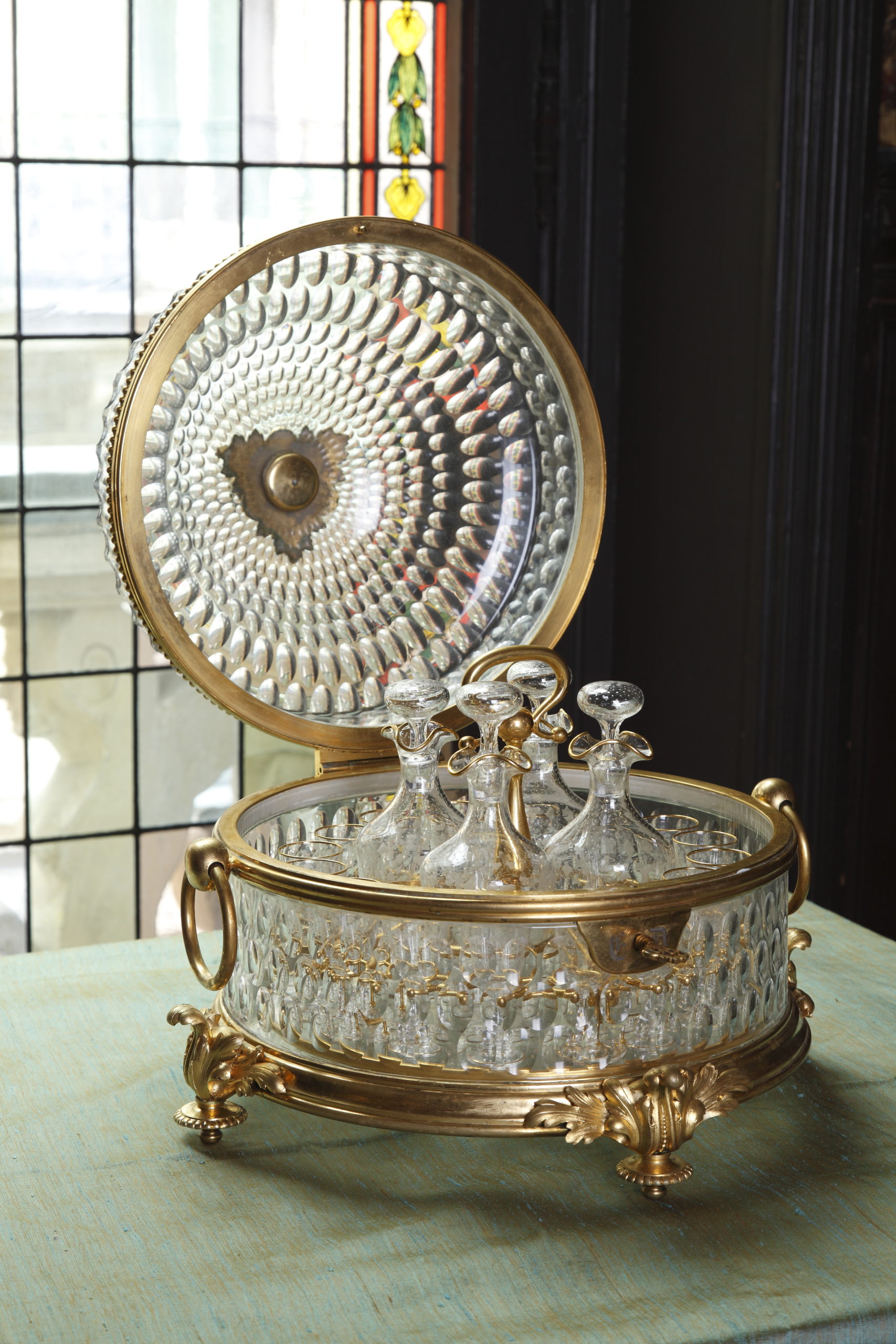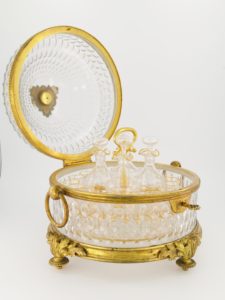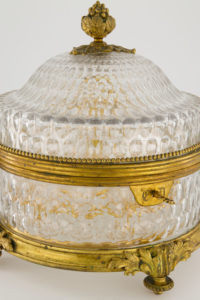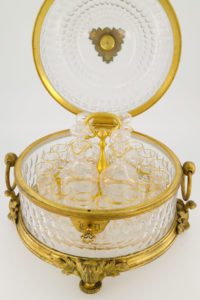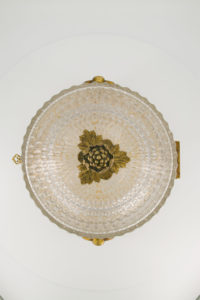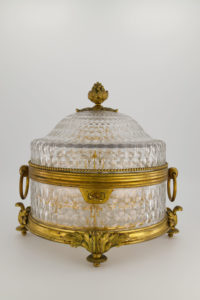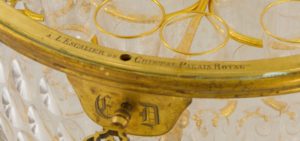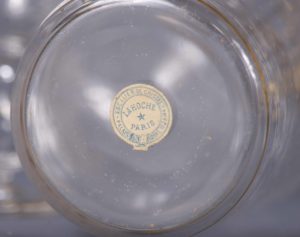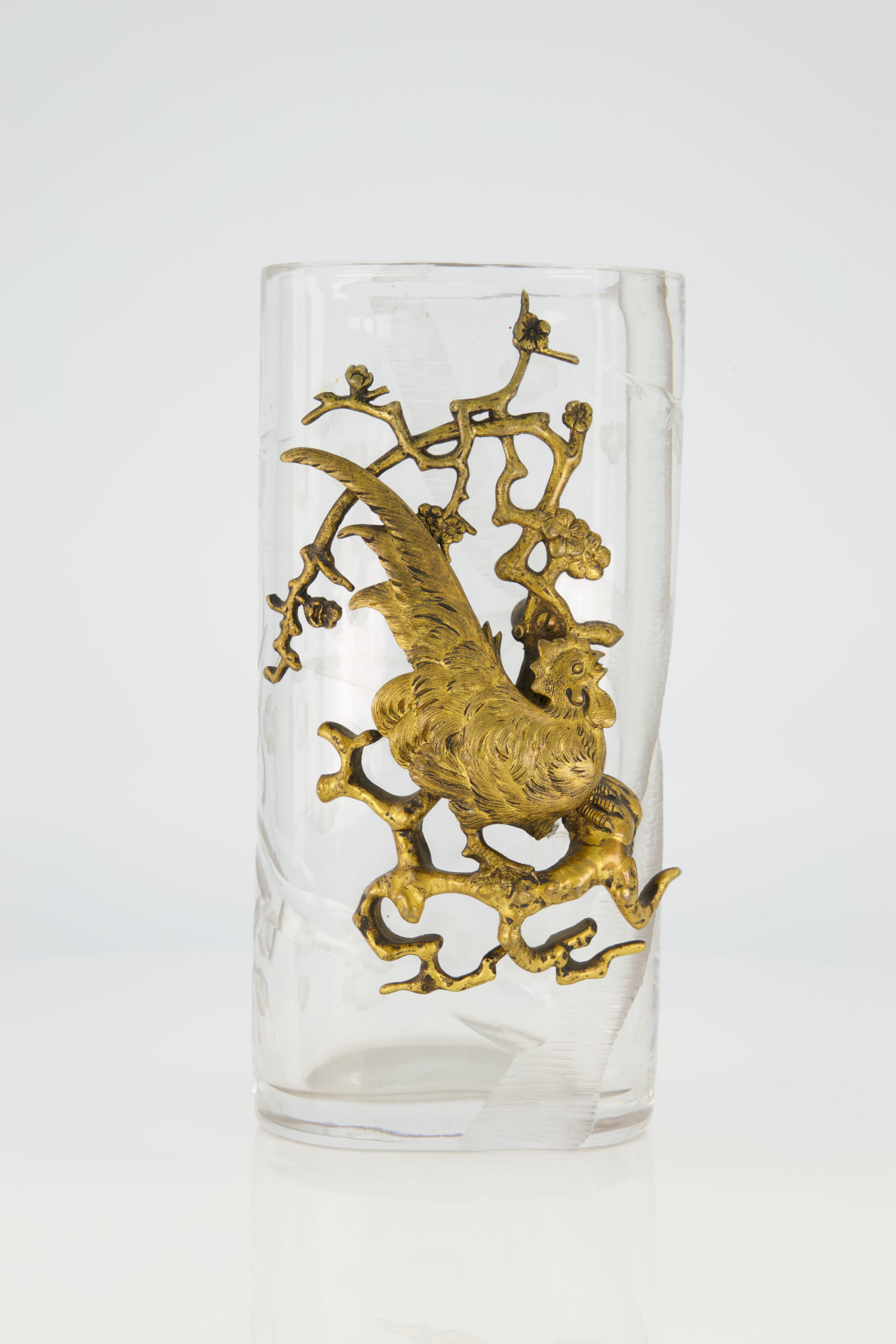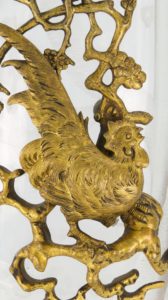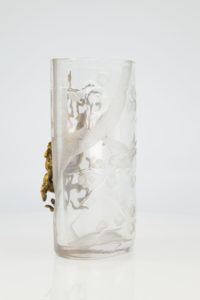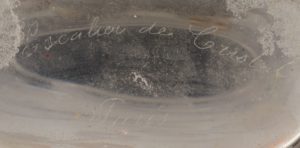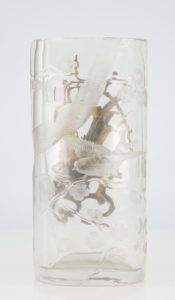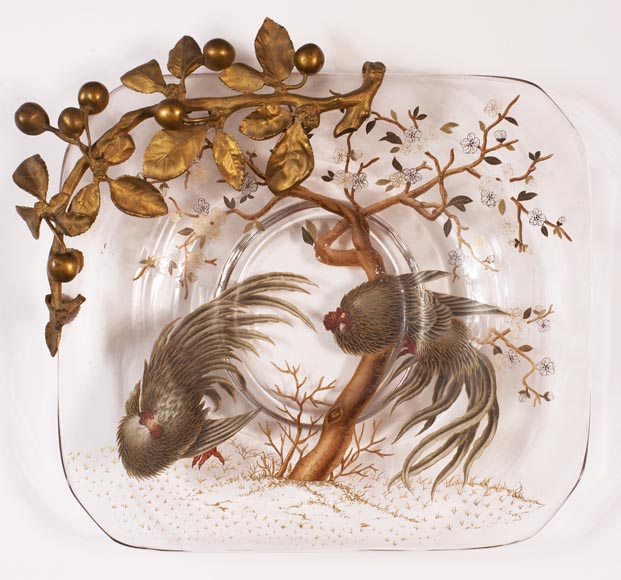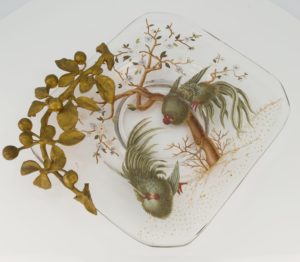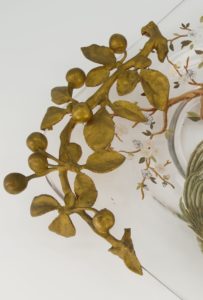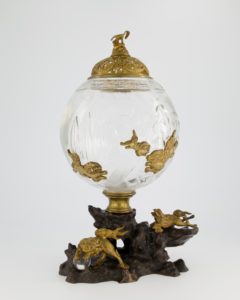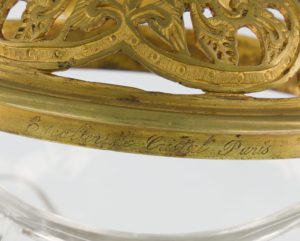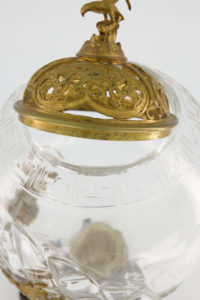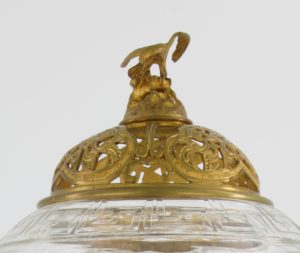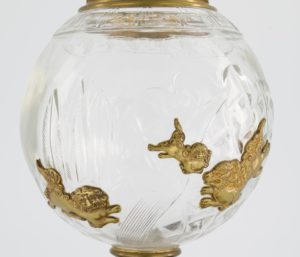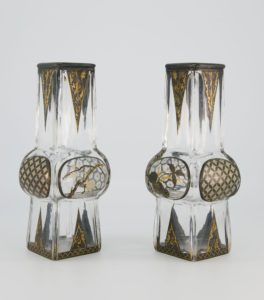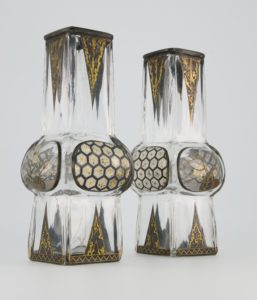The production of glass and especially crystal objects took its origin at the opening of the store around 1808. Despite the succession of different owners and the evolution of the tastes of the clientele throughout the 19th century, the creation of glassware remains among the must-see of l’Escalier de Cristal. We propose you to discover our collection presented in the chronological order of realization thus allowing to observe the evolution of the modes.
Signed ” à l’Escalier de Cristal Palais Royal” and label “Lahoche Paris”
Materials : Gilt bronze and crystal
Provenance : France, circa 1850
Dimensions : H : 36cm, D : 38 cm
Liquor cellar
The signature indicating the address of the store at Palais Royal as well as the label mentioning «Lahoche Paris» on one of the carafes, allow to date precisely this liquor cellar around 1850.
Combining crystal and bronze, our liqueur cellar plays on transparency : bronze serves as a structure for a crystal finely cut according to the honeycomb pattern. Inside, there is a set of two bottles and sixteen finely engraved glasses of grapefruit, the ends of which are underlined by a golden border. The bronze decoration is very fine and elaborate. The four feet are decorated with acanthus leaves, while the grip of the lid forms a blackberry surrounded by its leaves. In addition, on each side of the cellar two handles forming rings are hung. The lock certainly carries the monogram its former owner.
As is often the case in decorative arts, the decoration is in line with the function of the object. Thus for this temple of liquor are privileged vine leaves. Reflecting the eclecticism of the 19th century and the Napoleon III style, this liqueur cellar shows a taste for detail and ornamentation and the importance of the richness of the materials.
Cock vase
It is an elegant decoration around the theme of the cherry tree that is presented on this cylindrical flat crystal vase.
An emblematic tree of Japan, it is engraved on both sides of the vase. Nevertheless, on the main face, it appears in the background, supplanted by an applied gilded bronze decoration representing cherry blossom branches inhabited by a rooster, an animal frequently found in Asian prints. The carved and engraved decoration continues on the other side, extending it, but this time inhabited by a chickadee about to fly away.
Signed “Escalier de Cristal
Materials : Enamelled crystal and bronze
Provenance : France, circa 1885
Dimensions : H : 7 cm, L : 36,5 cm, P : 33cm
Rosters cup
The decoration of our cup is a very good example of how Japanese iconography inspired European artists in the second half of the 19th century. On this warm enamelled decoration with gold highlights, two cocks with long feathers clashing in front of a cherry blossom. The bronze frame with a brown patina represents a cherry branch that gently settles on the entire upper left portion of the cut
F. Bracquemond model
A study carried out by Felix Bracquemond in 1866 for the decoration of the Rousseau service is kept at the Musée d’Orsay. It shows a rooster whose position of the body and feathers is similar to one of the cocks adorning our cup. The decorations of this service had been commissioned from the artist by the merchant-editor of earthenware Eugène Rousseau (1827-1890).
The brothers Pannier, Georges and Henry chose to market unpublished works of art created in collaboration with Parisian artisans and sometimes even to be inspired by models already made. Thus, it is not surprising that for the decoration of this bowl, they called on the creators of the successful service of the second half of the 19th century, F. Bracquemond and E. Rousseau.
Vivarium
It consists of a carved crystal sphere mounted on a patinated bronze base with a rocky appearance. Two Foo dogs in gilt bronze whose postures bring an impression of movement and life embellish the base. Great importance is given to the details in this achievement. In particular, we can see that one of the two dogs has the front legs resting on a smaller crystal sphere. The main sphere is also decorated with Fô dogs in gilt bronze applied in engraved clouds and stylized foliage. A frieze of Greek keys is engraved under the lid in gilt bronze, finely openwork with oriental motifs, the shape of which takes the form of a bird of prey with outstretched wings.
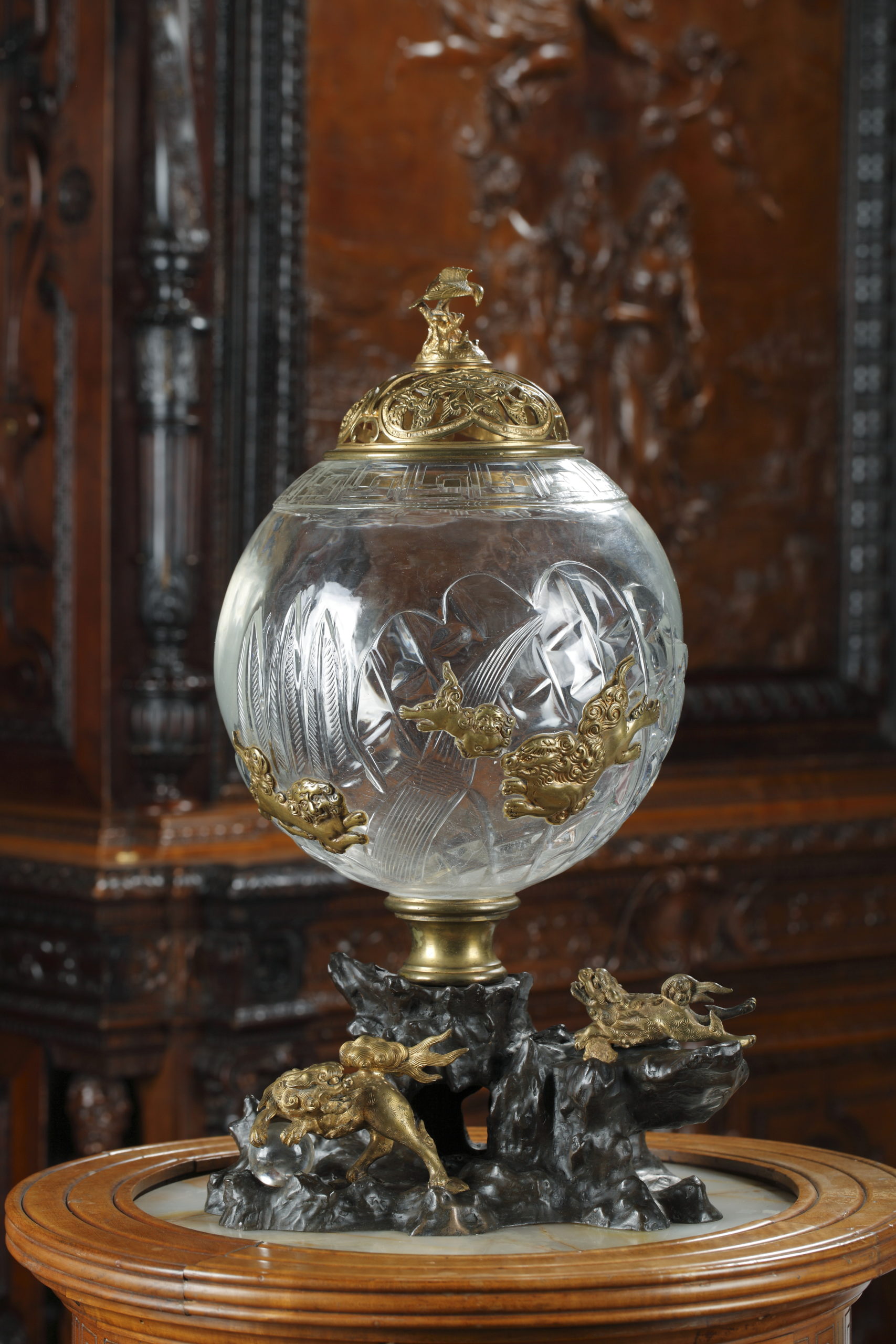
Signed « Escalier de Cristal Paris »
Materials : Crystal, patinated and gilt bronze
Provenance : France, circa 1885
Dimensions : H : 45 cm
Signed under the base « Escalier de Cristal Paris »
Materials : Enamelled crystal
Provenance : France, after 1885
Dimensions : H : 26cm
Pair of bamboo vases
Inspired by the shape of a bamboo, these two long square vases have a bulge in the middle. They are decorated with a graphic decoration engraved with acid and wheel, then enamelled in black, anthracite and gold tones using the Japanese iconographic vocabulary. The collar and the base are decorated on each side with triangles with a black background on which golden vegetated foliage motifs are drawn. The swollen part is decorated with decorations in the same tones in medallions. The upper perimeter has certainly been renovated.
The model
Their very original shape is inspired by a vase model presented at the Universal Exhibition of 1878. It is now in the Orsay museum and was created by Appert Frères (active between 1865 and 1931) for Eugène Rousseau (1827 – 1890). The latter, in a first merchant specialized in porcelain and earthenware, interested in glass from the years 1867 and commercializes a whole range of decor inspired by Japanese iconography and then in the spirit Art Nouveau. At the end of his career he went into partnership with Ernest Léveillé, who was also his pupil. Léveillé continued the work of Eugene Rousseau after his death, having bought the fund from his studio on “Rue Coquillière” in 1885.
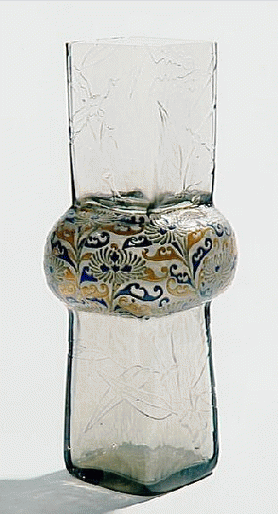
E. Rousseau, Appert Frères, Vase Bamboo model, circa 1878, Musée d’Orsay
